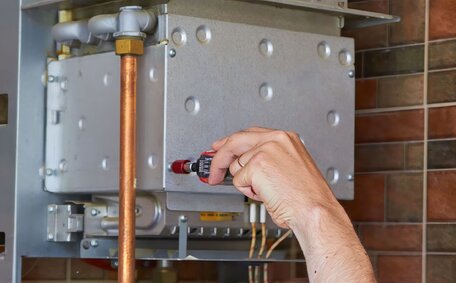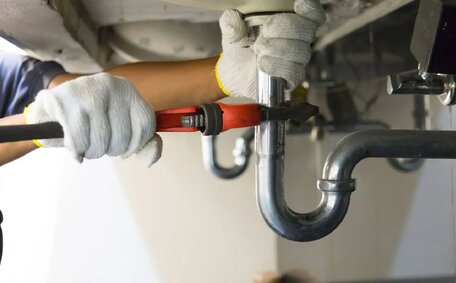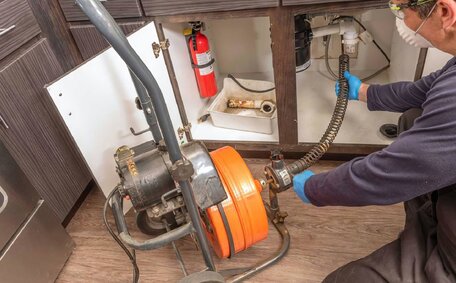Identifying If You Have a Manual or Electronic Ignition Pilot Light System
Determining whether your gas water heater has a manual or electronic ignition pilot light system is an important first step when addressing water heaters pilot relighting. This can typically be identified by checking the labelled instructions on your hot water system.
A manual ignition pilot light will have a dial or button that must be continuously pressed to activate the ignition and light the pilot. You manually ignite the pilot by pressing this dial while holding an ignition source to the pilot assembly. A manual ignition pilot light will have a dial or button that must be continuously pressed to activate the ignition and light the pilot.
An electronic ignition pilot system uses an electric igniter to automatically light the pilot when power is sent to the ignition control module. An electronic ignition pilot system uses an electric igniter to automatically light the pilot when power is sent to the ignition control module.
It will have buttons to activate and deactivate the electric igniter.
To locate your pilot light and tell which system you have:
- Look for the access panel on your water heater, removing any cover if needed.
- Identify the gas valve control with a dial, knob or buttons.
- Follow any instruction label on the valve controls.
- Check for a thin, white rod protruding from the pilot light assembly — this is the electric igniter in an electronic system.
Most heaters in Dulwich Hill installed prior to 2010 will likely have manual pilot control valves. Newer systems may have electronic ignition. Check your water heater’s labelling and controls to identify your pilot system type.
Safety First - Turning Off Gas Supply and Letting Residual Gas Clear Before Relighting
Safety should always be the top priority when working with gas appliances. An important first measure in understanding how relight a gas water heater’s pilot is to turn off the gas supply and let all residual gas fumes dissipate.
Start by locating the main gas shut off valve, typically found attached to the gas metre outside your home. Use a crescent wrench to turn the valve a quarter turn perpendicular to the pipe to shut off the gas.
Go back to your water heater and turn the gas control valve to the ‘off’ position. On a manual pilot system this will be turning a dial or switch to ‘off’. For an electronic system, press the button to deactivate the electronic ignition.
With the gas supply now shut off, allow 5-10 minutes for any residual gas in the pipes or around the water heater to dissipate. This greatly reduces the risk of ignition or explosion from errant fumes when you relight pilot systems.
Only once the waiting period has passed, should you attempt relighting the pilot following the below steps. Never strike an ignition source or press an ignition button while gas fumes may still be present.
Gathering Necessary Tools and Materials
Equipping yourself with the proper tools will ensure you understand exactly how relight the pilot process unfolds smoothly. While some manual ignition systems only require a simple piezo igniter wand, other items may be needed depending on your setup.
Typical materials and tools needed include:
- Piezo igniter wand (manual ignition)
- BBQ lighter or long match (manual ignition)
- Adjustable crescent wrench
- Screwdriver
- Replacement pilot assembly kit (in case pilot needs replacing)
- Flashlight
- Protective glove for hand using igniter/lighter
- Safety glasses
The piezo igniter wand is part of all manual pilot light assemblies and creates a spark to ignite the gas when the dial/button is pressed. Using a BBQ lighter or long match allows you to hold a flame to the pilot while activating the gas valve dial with your other hand.
A crescent wrench, screwdriver and flashlight help access the pilot assembly and provide visibility. Protective eyewear and gloves add important protection when dealing with an open flame.
Having a replacement pilot assembly on hand allows you to swap out the unit if troubleshooting determines the existing pilot is faulty and unable to hold a flame.
Step-by-Step Guide to Relighting the Pilot Light
Once you have identified your pilot system type, turned off the gas supply and allowed residual gas to dissipate, gathered the necessary tools, you are ready to relight the pilot.
Follow these key steps to safely relight your water heater’s pilot:
- Ensure the gas control valve is in the ‘off’ position before beginning.
- Remove any cover panels from the pilot assembly so it is fully accessible.
- For a manual pilot control:
- Turn the gas control dial/switch to the ‘pilot’ setting.
- Using a BBQ lighter or long match in one hand, hold the flame near the pilot light port.
- With your other hand, press and hold down the gas control dial.
- This will release gas flow and use your ignition source to manually light the pilot flame.
- Keep the dial depressed for 30-60 seconds, ensuring the pilot flame remains consistently lit.
- Release the dial and check that the pilot stays lit. If extinguished, repeat steps starting at step 1.
- For an electronic pilot control:
- Ensure batteries are installed in the ignition module.
- Press the ignition button which will create a spark to light the pilot flame.
- The flame sensor will automatically hold the gas valve open once lit.
- If the flame sensor does not detect the pilot flame, press the ignition button again.
- Once the pilot flame remains consistently lit, turn gas control to desired temperature setting.
By understanding how to efficiently relight pilot light on your water heater, you can adhere to these crucial steps for a safe process. Reinstall any removed cover panels once complete.
Troubleshooting Common Issues If Pilot Light Won’t Stay Lit
If your newly lit pilot light repeatedly goes out after following the above steps, there are a few key troubleshooting checks to try:
Manual Ignition Systems
A common issue is a faulty thermocouple not holding the pilot gas valve open. The thin thermocouple rod sits in the pilot flame and when heated, generates a small electrical signal. A common issue is a faulty thermocouple not holding the pilot gas valve open.
Over time, thermocouples can become corroded or damaged.
Try cleaning the thermocouple connector tip with fine sandpaper to remove any deposits. Also check it’s properly inserted in the gas control valve. If cleaning doesn’t help, the thermocouple likely needs replacing.
Check that gas is actually reaching the pilot assembly by testing at connection points. Listen for any hissing sound when the gas dial is pressed that would indicate gas flow.
Electronic Ignition Systems
The flame sensor rod detects the pilot flame similar to a thermocouple. If the flame sensor is dirty, it may fail to detect the pilot flame and automatically shut off gas flow.
Carefully clean the flame sensor rod with sandpaper, emory cloth or steel wool to remove deposits. Take care not to damage the sensor surface when cleaning.
Low batteries in the electronic ignition module can also prevent consistent sparking to keep the pilot lit. Replace batteries in the ignition controller if nearing end of lifespan.
Other Checks
- Inspect the pilot tubing and orifices for blockages preventing gas flow.
- Test gas line pressure to ensure adequate fuel supply to the pilot light.
- Examine pilot assembly for damage causing gas leaks.
- Review water heater manual for further brand and model-specific troubleshooting tips.
If you’ve attempted all troubleshooting steps and are located in the Dulwich Hill area but the pilot still fails to stay lit, contact a professional Dulwich Hill plumber for service as a larger underlying issue may need repair.
Knowing When to Call a Professional Plumber
While relighting your water heater’s pilot light is often a straightforward DIY task, there are certain scenarios where it’s best to call a professional Dulwich Hill plumber for assistance:
- If you’ve made multiple attempts to relight the pilot but it fails to stay lit after trying all troubleshooting tips, this indicates a larger underlying issue that requires a professional repair.
- If you smell a strong gas odour that persists even after attempting to relight the pilot, this could signal a dangerous gas leak needing immediate professional attention for safe repair.
- If upon inspection, you discover substantial corrosion, damage or defects to the gas valve, piping or other integral components, replacement parts or repairs may be beyond a basic DIY fix.
- If the pilot assembly requires complete replacement, a licenced professional should perform installation of the new pilot system to ensure proper setup and function.
- If your property uses liquid propane (LP) gas rather than natural gas, as the LP setup introduces additional complexity, call a qualified technician.
For professional plumbing repairs and services in the Dulwich Hill area, contact the experts at Dulwich Hill Plumbing on 1300 349 338 or email [email protected].
Our licenced, fully qualified technicians have the proper training, expertise and equipment to accurately diagnose issues and make all necessary repairs to safely relight your water heater pilot light.
Maintaining Your Water Heater for Reliability
Performing regular maintenance on your gas water heater can help minimise pilot light issues and enhance overall system reliability and safety.
Simple maintenance tasks you can do include:
- Visually inspecting piping connections, the gas valve and burner area for corrosion or leaks annually.
- Testing water temperature and pressure yearly to ensure proper function.
- Flushing the tank to remove sediment buildup every 6-12 months depending on water quality.
- Checking that ventilation openings or exhaust flues are clear of obstructions.
Beyond DIY checks, professional maintenance from a qualified Dulwich Hill plumber should also be scheduled periodically.
Through detailed inspections, a plumber will:
- Assess all components like the burner, thermocouple, piping and valves.
- Check carbon monoxide (CO) emissions levels meet safety standards.
- Test functionality of electronic ignition modules and back-up thermal switch.
- Verify adequate water pressure and anti-scale treatments.
Preventative maintenance helps spot potential points of failure before they occur. Catching and replacing a faulty thermocouple before it fails, for example, eliminates the inconvenience of your pilot light repeatedly going out.
Likewise, confirming safe CO emissions prevents risk of dangerous exposure. Checking your anode rod allows the plumber to advise replacement if corroded before tank leaks develop.
Investing in preventative water heater servicing ultimately saves money over dealing with emergency breakdowns. It also reduces personal disruption from unexpected cold showers or baths!
For professional maintenance of your residential or commercial water heater in Dulwich Hill, call the licenced experts at Dulwich Hill Plumbing on 1300 349 338.






